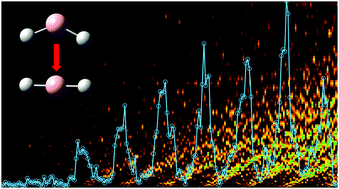Photoelectron spectroscopy of boron-containing reactive intermediates using synchrotron radiation: BH2, BH, and BF†
Abstract
Mass selected slow photoelectron spectra (SPES) of three boron-containing reactive species, BH2, BH, and BF were recorded by double imaging photoion–photoelectron coincidence spectroscopy (i2PEPICO) using synchrotron radiation. All species were generated in a flow reactor from the H-abstraction of B2H6 by F atoms created in a F2 microwave discharge. The spectrum of BH2+ exhibits a long bending mode progression with a 970 cm−1 spacing due to the large geometry change from bent to linear upon ionization. Its ionization energy was determined as 8.12 ± 0.02 eV. For BH, photoionisation from both X1Σ+ singlet and a3Π triplet state was observed, permitting the experimental determination of the singlet/triplet gap (ΔEST) from the observed IE's of 9.82 eV and 8.48 eV. In addition, a threshold photoelectron spectrum of BF was recorded, which leads to an IE of 11.11 eV and an improved value for νBF+ of 1690 cm−1. All spectra were simulated by calculating Franck–Condon factors from optimised structures based on quantum chemical calculations.

- This article is part of the themed collections: PCCP Editor’s Choice, 2020 and 2019 PCCP HOT Articles


 Please wait while we load your content...
Please wait while we load your content...